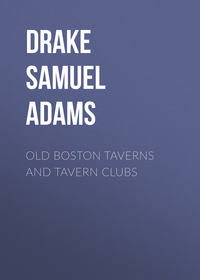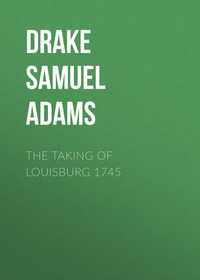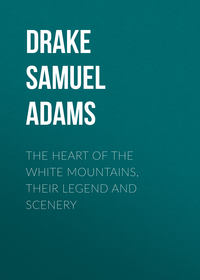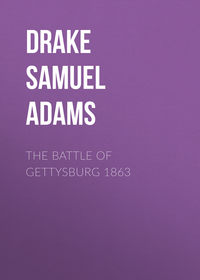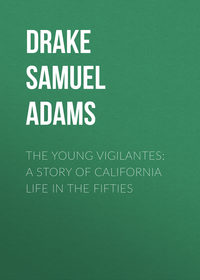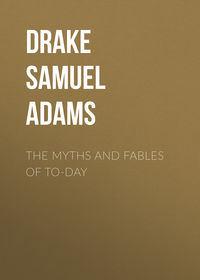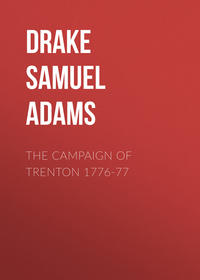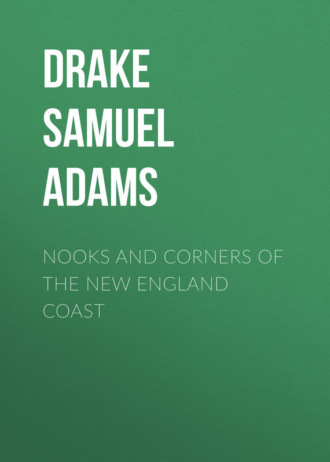 полная версия
полная версияNooks and Corners of the New England Coast
210
"Massachusetts Archives."
211
There is a well-defined line of demarkation between the almost uninterrupted rock wall of the north coast and the sand, which, beginning in the Old Colony, in Scituate, constitutes Cape Cod; and, if we consider Nantucket, Martha's Vineyard, and Long Island as having at some period formed the exterior shores, the almost unbroken belt of sand continues to Florida. This line is so little imaginary that it is plain to see where granite gives place to sand; and it is sufficiently curious to arrest the attention even of the unscientific explorer.
212
"Lequel nous nommâmes C. Blanc pour ce que c'estoient sables et dunes qui paroissent ainsi."
213
Named by Captain Gosnold, on account of the expressed fears of one of his company.
214
Being the 21st of November, it would fall quite near to the day usually set apart for Thanksgiving in New England, which is merely an arbitrary observance, commemorative of no particular occurrence.
215
One of De Monts's men ("un charpentier Maloin") was killed here in 1605 by the natives. In attempting to recover a kettle one of them had stolen, he was transfixed with arrows.
216
Lescarbot adds that the natives, turning their backs to the vessel, threw the sand with both hands toward them from between their buttocks, in derision, yelling like wolves.
217
Hubbard relates a terrific storm here. See "New England," p. 644. In 1813 there was a naval engagement at Provincetown.
218
General Knox was interested in this project. Lemuel Cox, the celebrated bridge architect, was engaged in cutting it.
219
Champlain confirms this.
220
Prior was personally acceptable to Louis XIV., who gave him a diamond box with his portrait. He was also well known to Boileau.
221
Captain David Smith and Captain Gamaliel Collins.
222
In old times a decoction of checker-berry leaves was given to lambs poisoned by eating the young leaves of the laurel in spring.
223
There is an authentic account of ice being found here on the 4th of July, 1741.
224
When the English first settled upon the Cape there was an island off Chatham, three leagues distant, called Webb's Island. It contained twenty acres, covered with red-cedar or savin. The Nantucket people resorted to it for fire-wood. In 1792, as Dr. Morse relates, it had ceased to exist for nearly a century. "A large rock," he says, "that was upon the island, and which settled as the earth washed away, now marks the place."
225
Amos Otis, in the "New England Historical and Genealogical Register," 1865.
226
Purchas, iv.; reprinted in "Massachusetts Historical Collections," iii., viii. I can not give space to those points that confirm my view, but they make a strong presumptive case. It has been alleged that De Poutrincourt landed here after his conflict with the Indians of Cape Cod. So far from landing on the island they saw, Champlain says they named it "La Soupçonneuse," from the doubts they had of it. Lescarbot adds that "they saw an island, six or seven leagues in length, which they were not able to reach, and so called 'Ile Douteuse.'" The land, it is probable, was the Vineyard.
227
By Sir F. Gorges.
228
Nantasket, Namasket, Naushon, Sawtuckett, are Indian.
229
In 1602 by the colony of Bartholomew Gosnold, already so often mentioned in these pages.
230
Better known as Holmes's Hole.
231
On the raising of the ice-blockade of the past winter seventeen mails were due, the greatest number since 1857, when twenty-five regular and two semi-monthly mails were landed at Quidnet.
232
In 1837 its population was 9048; it is now a little more than 4000.
233
The Dutch also whaled with long ropes, as is now our method.
234
Weymouth also describes the Indian manner of taking whales: "One especial thing is their manner of killing the whale, which they call powdawe; and will describe his form; how he bloweth up the water; and that he is twelve fathoms long; and that they go in company of their King, with a multitude of their boats, and strike him with a bone made in the fashion of a harping-iron, fastened to a rope, which they make great and strong of the bark of trees, which they veer out after him; that all their boats come about him, and as he riseth above water, with their arrows they shoot him to death. When they have killed him and dragged him to shore, they call all their chief lords together, and sing a song of joy; and these chief lords, whom they call sagamores, divide the spoil, and give to every man a share, which pieces so distributed they hang up about their houses for provision; and when they boil them, they blow off the fat, and put to their pease, maize, and other pulse which they eat." – "Weymouth's Voyage."
235
Nantucket in 1744 had forty sloops and schooners in the whale-fishery. The catch was seven thousand to ten thousand barrels of oil per annum. There were nine hundred Indians on the island of great use in the fishery. – Douglass, vol. i., p. 405.
236
State papers.
237
Gordon, vol. i., p. 463.
238
Records of Congress.
239
Of Macy it is known that he fled from the rigorous persecution of the Quakers by the government of Massachusetts Bay. The penalties were ordinarily cropping the ears, branding with an iron, scourging, the pillory, or banishment. These cruelties, barbarous as they were, were merely borrowed from the England of that day, where the sect, saving capital punishment, was persecuted with as great rigor as it ever was in the colonies. The death-penalty inflicted in the Bay Colony brought the affairs of the Friends to the notice of the reigning king. Thereafter they were tolerated; but as persecution ceased the sect dwindled away, and in New England it is not numerous. The Friends' poet sings of Macy, the outcast:
"Far round the bleak and stormy CapeThe vent'rous Macy passed,And on Nantucket's naked isleDrew up his boat at last."240
Thurloe, vol. v., p. 422.
241
The nine were Tristram Coffin, Thomas Macy, Christopher Hussey, Richard Swain, Thomas Barnard, Peter Coffin, Stephen Greenleaf, John Swain, and William Pile, who afterward sold his tenth to Richard Swain.
242
John Smith, Nathaniel Starbuck, Edward Starbuck, Thomas Look, Robert Barnard, James Coffin, Robert Pike, Tristram Coffin, Jun., Thomas Coleman, and John Bishop.
243
Of three hundred and fifty-eight Indians alive in 1763, two hundred and twenty-two died by the distemper.
244
Hutchinson.
245
Zaccheus Macy, in his account of the island, written in 1792, says none had been taken up to that time – "a great loss to the islanders."
246
The Indian name Tuckanuck signifies a loaf of bread.
247
Rev. F. C. Ewer, of New York.
248
Judah Touro, the philanthropist, was born here in Newport, in 1775, the year of American revolt. His father, the old rabbi, Isaac, came from Holland, officiating as preacher in 1762 in Newport. When still a young man, Judah Touro removed to New Orleans, where he acquired a fortune. He was a volunteer in the battle of 1815, and was wounded by a cannon-ball in the hip. Though a Jew, Judah Touro was above sect, generously contributing to Christian church enterprises. Bunker Hill Monument, toward which he gave ten thousand dollars, is a memorial of his patriotic liberality.
249
At Naples the summer temperature is seldom above 73°; in winter it does not fall below 47°.
250
Point Judith is named from Judith Quincy, the wife of John Hull, coiner of the rare old pine-tree shillings of 1652.
251
Beaver Tail is a peninsula at the southern extremity of Canonicut Island, so named from its marked resemblance, on the map, to the appendage of the beaver.
252
Fort Adams is situated at the upper (northern) end of a point of land which helps to form the harbor of Newport; it also incloses a piece of water called Brenton's Cove.
253
By our American Grace Darling, Miss Ida Lewis.
254
Goat Island was the site of a colonial fortress. During the reign of King William, Colonel Romer advised the fortification of Rhode Island, which he says had never been done "by reason of the mean condition and refractoriness of the inhabitants." In 1744 the fort on Goat Island mounted twelve cannon. At the beginning of the Revolution General Lee, and afterward Colonel Knox, marked out defensive works; but they do not appear to have been executed when the British, on the same day that Washington crossed the Delaware, took possession of the island. The Whigs, in 1775, removed the cannon from the batteries in the harbor. Major L'Enfant, the engineer of West Point, was the author of Fort Wolcott.
255
There should be added to the detail of maps given in the initial chapter that of Jerome Verrazani, in the College de Propaganda Fide, at Rome, of the supposed date of 1529. This map is described and discussed, together with the detail of Giovanni Verrazani's letter to Francis I., dated at Dieppe, July 8th, 1524, in "Verrazano, the Navigator," by J. C. Brevoort. A reduced copy of the map or "Planisphere" is there given. The author adopts the theory, not without plausibility, that Verrazani passed fifteen days at anchor in Narraganset Bay. As I have before said, there is something of fact in these early relations; but if tested by the only exact marks given (latitude, distances, and courses), they establish nothing.
256
Harrison, the first architect of his day in New England, was the author of many of the older public buildings in Newport, Trinity Church and Redwood Library among others. He also designed King's Chapel, Boston, and did what he could to drag architecture out of the mire of Puritan ugliness and neglect.
257
He owned, besides his house and garden in Boston, lands at Mount Wollaston, now Quincy, Massachusetts. Coddington is mentioned in Samuel Fuller's letter to Bradford, June, 1630. "Mrs. Cottington is dead," he also says.
258
It may be found at length in Hutchinson, appendix, vol. ii. Governor Hutchinson was a relative of the schismatic Anne.
259
This was called an appeal to the country. A judge would hardly, at the present day, permit such an expression in court.
260
William Wanton, 1732 to 1734; John Wanton, 1734 to 1741; Gideon Wanton, 1745 to 1746, and from 1747 to 1748; Joseph Wanton, from 1769 to 1775. The last named left Newport with the British, in 1780, and died in New York. His son Joseph, junior, commanded the regiment of loyalists raised on the island.
261
One of the most curious chapters of Rhode Island's political history was the "Dorr Rebellion" of 1842, growing out of a partial and limited franchise under the old charter.
262
A fund bequeathed by Abraham Touro, who died in Boston in 1822, secures this object.
263
It was incorporated 1747: the same year Mr. Redwood gave five hundred pounds sterling, in books, or about thirteen hundred volumes. The lot was the gift of Henry Collins, in 1748; building erected 1748-'50; enlarged in 1758; and now (1875) a new building is erecting. Abraham Redwood was a native of Antigua. When the library sent its committee to Stuart, with a commission to paint a full-length portrait of Mr. Redwood, Stuart refused, for reasons of his own, to execute it.
264
Dr. Ezra Stiles was librarian for twenty years.
265
The discovery of any portion of the coast of New England by Northmen belongs to the realms of conjecture. It is not unreasonable to suppose that they may have fallen in with the continent; but what should have brought them so far south as Rhode Island, when Nova Scotia must have appeared to their eyes a paradise? The vine grows there. Champlain called Richmond's Island Isle de Bacchus, on account of its grapes.
266
"Travels in New England and New York: " New Haven, 1822, vol. iii., p. 56.
267
Among the records of Newport was found one of 1740, in which Edward Pelham bequeathed to his daughter eight acres of land, "with an Old Stone Wind Mill thereon standing and being, and commonly called and known as the Mill Field." The lane now called Mill Street appears to have been so named from its conducting up the hill to the mill. The wife of Pelham was granddaughter of Governor Benedict Arnold. In the governor's will, dated in 1677, he gives direction for his burial in a piece of ground "being and lying in my land in or near ye line or path from my dwelling-house, leading to my stone-built Wind Mill in ye town of Newport above mentioned."
268
I incline to the opinion that the Indians had here, as at Plymouth, cleared a considerable area. There the carpenters had to go an eighth of a mile for timber suitable for building.
269
Within five miles of Boston is standing an ancient stone windmill, erected about 1710. It had been so long used as a powder-magazine that no tradition remained in the neighborhood that it had ever been a windmill. They still call it the Old Powder-house.
270
The keys are compound, and, though rude, are tolerably defined. No two are alike; they are generally of a hard gray stone, instead of the slate used in the structure.
271
This building may have been mentioned by Church in his account of Philip's War, when, after some display of aversion on the part of a certain captain to a dangerous enterprise, he was advised by the Indian fighter to lead his men "to the windmill on Rhode Island, where they would be out of danger."
272
Many of these so-called cottages cost from $50,000 to $200,000. For the season, $2000 is considered a moderate rental, and $5000 is frequently paid.
273
"R. Goodloe Harper's Speeches, p. 275."
274
By smashing their frigates, L'Insurgente, La Vengeance, Berceau, and making it generally unpleasant for them.
275
Duke de Feltre, French minister of war.
276
He afterward returned to France, and was made minister of war.
277
Fort Morgan was constructed by him with twelve posterns, a statement significant to military engineers. General Totten closed six of them, and the Confederates, when besieged, all but two.
278
Canonicut is about seven miles long, its longest axis lying almost north and south. It includes a single township, incorporated 1678, by the name of Jamestown. The island was purchased from the Indians in 1657. Prudence Island, six miles long, is also attached to Jamestown.
279
At this time four British frigates and several smaller craft were destroyed. The French forced the passage on the west of Canonicut, and raised the blockade of Providence.
280
The chasm is one hundred and sixty feet in length, with an average depth of about sixty feet.
281
Smibert planned the original Faneuil Hall, Boston. Trumbull painted in the studio left vacant bv Smibert.
282
British ambassador at St. Petersburg, afterward Lord Malmesbury.
283
Massachusetts Files.
284
Heath then commanded at Providence: he was ordered to meet Rochambeau on his arrival, and extend any assistance in his power.
285
The manner and matter of his reception of Mr. Adams were equally those of gentleman and king. Contrast him with the Prince Regent, and his remark to the French ex-minister, Calonne, during his father's sudden illness, in 1801: "Savez-vous, Monsieur de Calonne, que mon père est aussi fou que jamais?" (Do you know, Monsieur de Calonne, that my father is as crazy as ever?) Thackeray could not do him justice.
286
The fellow-prisoner of Count Christian Deux-Ponts was an Irishman, named Lynch, who belonged also to Rochambeau's army. Fearful that his nationality might be discovered, he begged the count to be on his guard. When at table, and heated with wine, the secret was divulged by the count; but Nelson, as Ségur relates, pretended not to have heard it.
287
That of Major Galvan, who pistoled himself on account of unrequited love.
288
Rally, Auvergne! here is the enemy!
289
William Ellery Channing, the pastor of "Old Federal Street," Boston, was one of the most gifted and eloquent men the American pulpit has produced. His mother was the old signer's daughter.
290
When appealed to by the United Colonies in 1657 to punish Quakers, Rhode Island objected that no law of that colony sanctioned it. The president, Benedict Arnold, however, replied that he (and the other magistrates) conceived the Quaker doctrines tended to "very absolute cutting down and overturning relations and civil government among men." He urged as a measure of public policy that the Quakers should not be molested, as they would not remain where the civil authority did not persecute them. This has, in fact, been the history of this sect in New England. – See Arnold's letter, Hutchinson, vol. i., appendix.
291
George Fox was in Rhode Island in 1672. On arriving at Newport, he went to the house of Nicholas Easton, who was then governor, and remained there during his sojourn. A yearly meeting of all the Friends in New England was held while he remained in Newport. – "George Fox his Journal," London, 1709.
292
Josselyn mentions the sect: "Narraganset Bay, within which bay is Rhode Island, a harbor for the Shunamitish Brethren, as the saints errant, the Quakers, who are rather to be esteemed vagabonds than religious persons." He also attributes to them dealings in witchcraft. Whittier, the Quaker poet, has depicted in stirring verse the persecutions of this people. Cassandra Southwick is from real life.
293
Stones giving simply the name and date of decease are now allowed.
294
In 1708 M. de Subercase solicited of his Government the means of attempting an enterprise against the island of Rhode Island. He says, "Cette isle est habitée par des Coakers qui sent tous gens riches."
295
Here also is the grave of Governor Henry Bull, who died in 1693, and whose ancient stone house is now standing in Spring, near Sherman Street.
296
Stuart was in Boston at the time of the battle of Lexington, and managed to escape a few days after Bunker Hill. His obituary in the Boston Daily Advertiser, a very noble tribute from one man of genius to another, was written by Allston.
297
It was the fortress of the British left wing. Two large and elegant country houses at its base, included within the lines, were occupied by the officers.
298
He was the son of John, the son of Godfrey Malbone.
299
The first bridge spanning what was known as Howland's Ferry was completed in 1795. It was of wood, destroyed and swept to sea by a storm; rebuilt, and again destroyed by worms. The present stone structure was built in 1809-'10, and, though injured by the gale of 1815, stands firm.
300
The battle was fought in the valley below Quaker, sometimes called Meeting-house, Hill. Sullivan commanded in chief, though Greene is entitled to a large share of the credit of repulsing the British attack. It was a well-fought action. Pigot, by British accounts, had six thousand regular troops. Lafayette was mad as a March hare at their fighting without him.
301
Lechford, writing between 1637 and 1641, says: "At the island called Aquedney are about two hundred families. There was a church where one Master Clark was elder: the place where the church was is called Newport, but that church, I hear, is now dissolved. At the other end of the island there is another town called Portsmouth, but no church. Those of the island have a pretended civil government of their own erection without the king's patent."
302
To be exact, the shores adjacent to the rock are in the town of Berkeley, formerly part of Dighton.
303
A copy of the inscription, made by Professor Sewall, is deposited in the Museum at Cambridge. There is another copy, by James Winthrop; see plate in vol. iii., "Memoir American Academy," and description of method of taking it, vol. ii., part ii., p. 126. Many others have been taken, more or less imperfect; the best one recollected is in the hall of the Antiquarian Society, Worcester, Massachusetts.
304
Watch Hill, in the town of Westerly and near Stonington, is the south-western extremity of Rhode Island.
305
Named from Captain Adrian Blok, a Dutch navigator. Its Indian name was Manisses. There are about twelve hundred inhabitants on this island, all native-born, of whom two hundred and seventy-five are voters. There are also six schools, two Baptist churches, and two windmills, a hotel, and several summer boarding-houses. Two hundred fishing-boats are owned by the islanders. In 1636 John Oldham, mentioned in our ramble in Plymouth, was murdered here by the Pequots. Block Island in 1672 was made a township, by the name of New Shoreham.
306
The two forts, Trumbull and Griswold, are named from governors of Connecticut. They date from the Revolution. Fort Trumbull in its present form was completed in 1849, under the supervision of General G. W. Cullum, U. S. A. In passing through New London in April, 1776, General Knox, by Washington's direction, examined the harbor with the view of erecting fortifications, and reported, by letter, that it would, in connection with Newport, afford a safe retreat to the American navy or its prizes in any wind that blew.
307
Son of Governor Winthrop, of Massachusetts. He passed his first winter on Fisher's Island, which remained in his family through six generations. The valuable manuscript collection known as the Winthrop papers was found some years ago on the island, which belongs to New York in consequence of the grants to the Earl of Sterling and the Duke of York. The origin of its present name is uncertain, though so called as early as 1636. Governor Winthrop relates to Cotton Mather a singular incident which happened on Fisher's Island the previous winter. During the severe snow-storms hundreds of sheep, besides cattle and horses, were buried in the snow. Even the wild beasts came into the settlements for shelter. Twenty-eight days after the storm alluded to, the tenants of Fisher's Island, in extricating the bodies of a hundred sheep from one bank of snow in the valley, found two alive in the drift, where they had subsisted by eating the fleeces of those lying dead near them.


